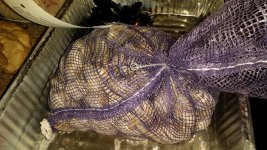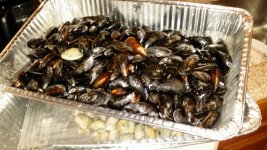Great info Paul and I agree with your opinion on underfeeding contributing to issues with health, immunity, HLLE, etc. It was great to finally meet you at NERAC last weekend! BTW- did you happen to notice the clarions in the "bubble" tank to the left of Joe's reef? The aquarist who manages that tank has stated they've been spawning constantly on our food. (I know its a shameless plug but it proves your point.)
When I did my talk last month at the Omaha, NE Zoo much of it was devoted exactly to the topic of nutritional deficiencies in captive aquariums. In an effort to maintain pristine water quality many home aquarists under feed or feed poor quality food with denatured (broken down) proteins that are nutritionally void in comparison to whole foods. This is why unmolested, chemically free and fresh seafood has a profound effect on eliciting a feeding response and health in the animal. I'm not just saying that about our food, but with any clam pulled fresh from the water like Paul recommends you are a step ahead of the game. Our supplementation with D. salina micro algae and beneficial probiotic bacteria is designed to specifically boost nutritional value and help fish metabolize and ingest the nutrients in the food as much as possible, knowing that some nutrients get "lost" due to freezing, thawing, processing, etc.
Obviously as food makers we are limited in the choices of raw ingredients, like you noted with the adductor muscle of the scallop verses the entire scallop. However, supplementation with whole organisms such as the Mysis, plankton, blackworms and fish eggs helps close the gap as best we can for a commercial food product.
As far as healthy fish = spawning fish I cannot argue there.
In 2015 LRS Foods became sponsors of the Rising Tide Conservation project and began to send food to the Tropical Aqua Lab at the University of Florida for testing and evaluation. The results have been remarkable with increased spawns and more robust larvae to say the least. Diversity of ingredients can have a marked benefit on overall health by providing as complete nutrition as possible in a captive aquarium. I guess the moral to the story is to feed often, feed varied ingredients and seek pure sources for foods.
The next post to this Melanarus Wrasse breeding success will mention the broodstock diet and I am eagerly awaiting it to post.
 http://risingtideconservation.blogspot.com/2015/02/early-success-with-halichoeres-wrasse.html
http://risingtideconservation.blogspot.com/2015/02/early-success-with-halichoeres-wrasse.html
While in NY for NERAC I had the opportunity to re-visit a handful of the G. personatus angels from the Hawaii project and they are growing up nicely! I have personally fed eleven (11) G. personatus in NY which have been feeding on LRS and other foods for months and seem to be doing just fine. Our third order arrived in Japan last week destined for some of the rarest fish on the planet including Narcosis and other angels. No deleterious effects have been reported since November when the first order arrived.
https://youtu.be/vyshy0D8Ok4
Feed your fish and keep them happy! More water changes may be needed but your fish will thank you for it. You guys are lucky in NY you can get fresh seafood for DIY blends as many people in the US cannot.
Talk soon Paul!
Larry
Owner
LRS Foods
PS-Edit: For those interested here is a link to the post regarding black worms and fish eggs in our blends:
http://www.manhattanreefs.com/forum...renzy-blend-now-has-blackworms-fish-eggs.html









